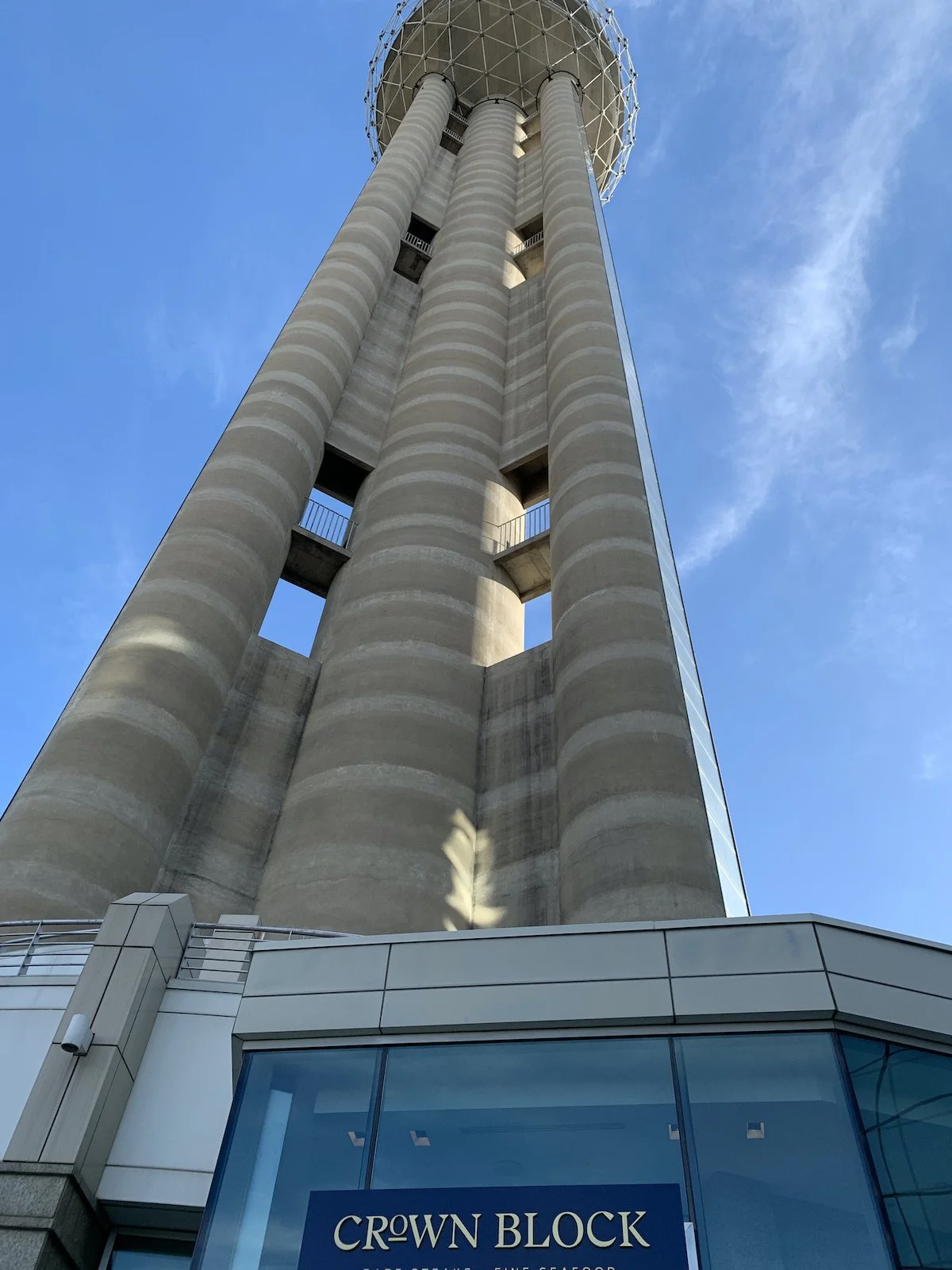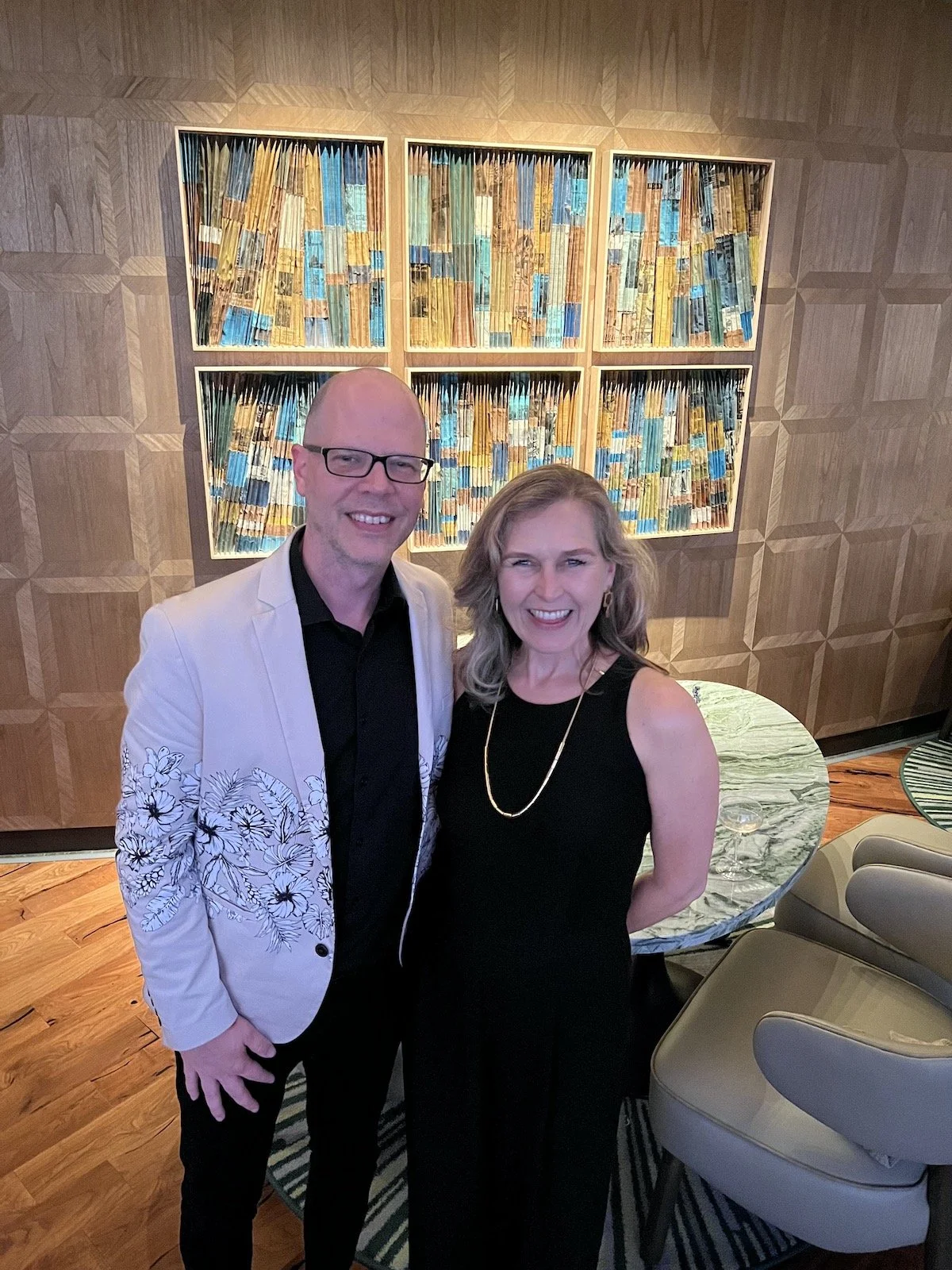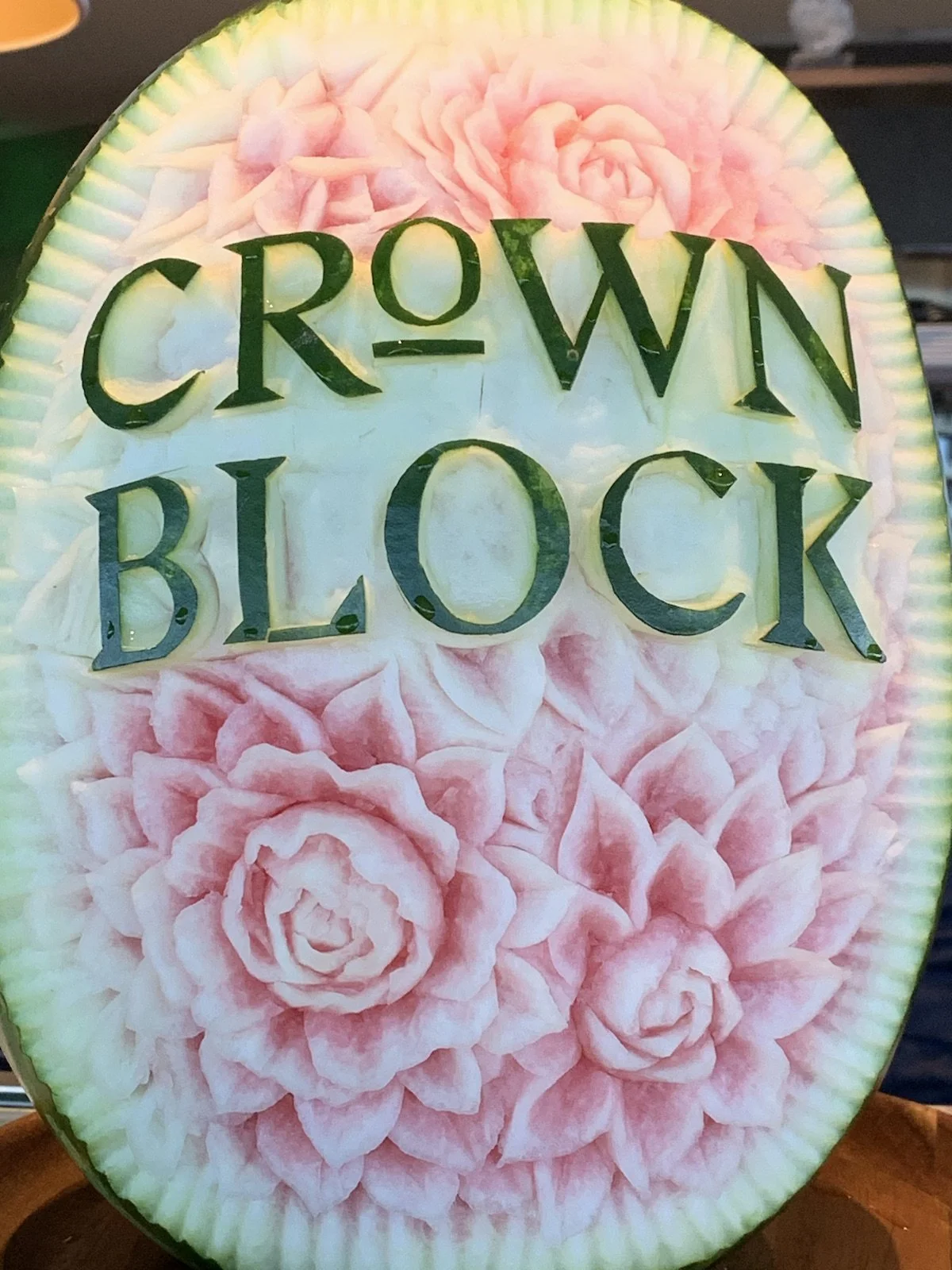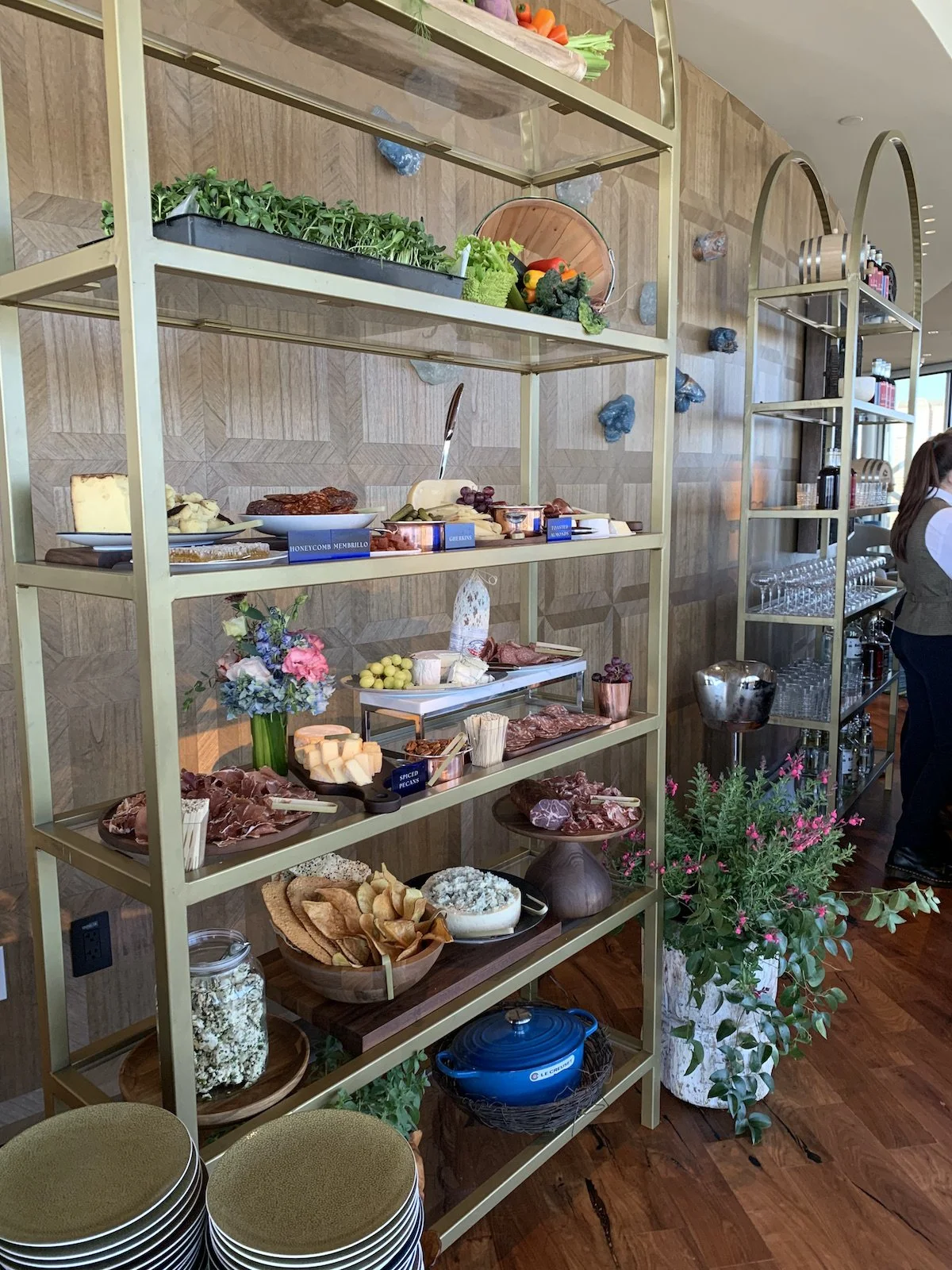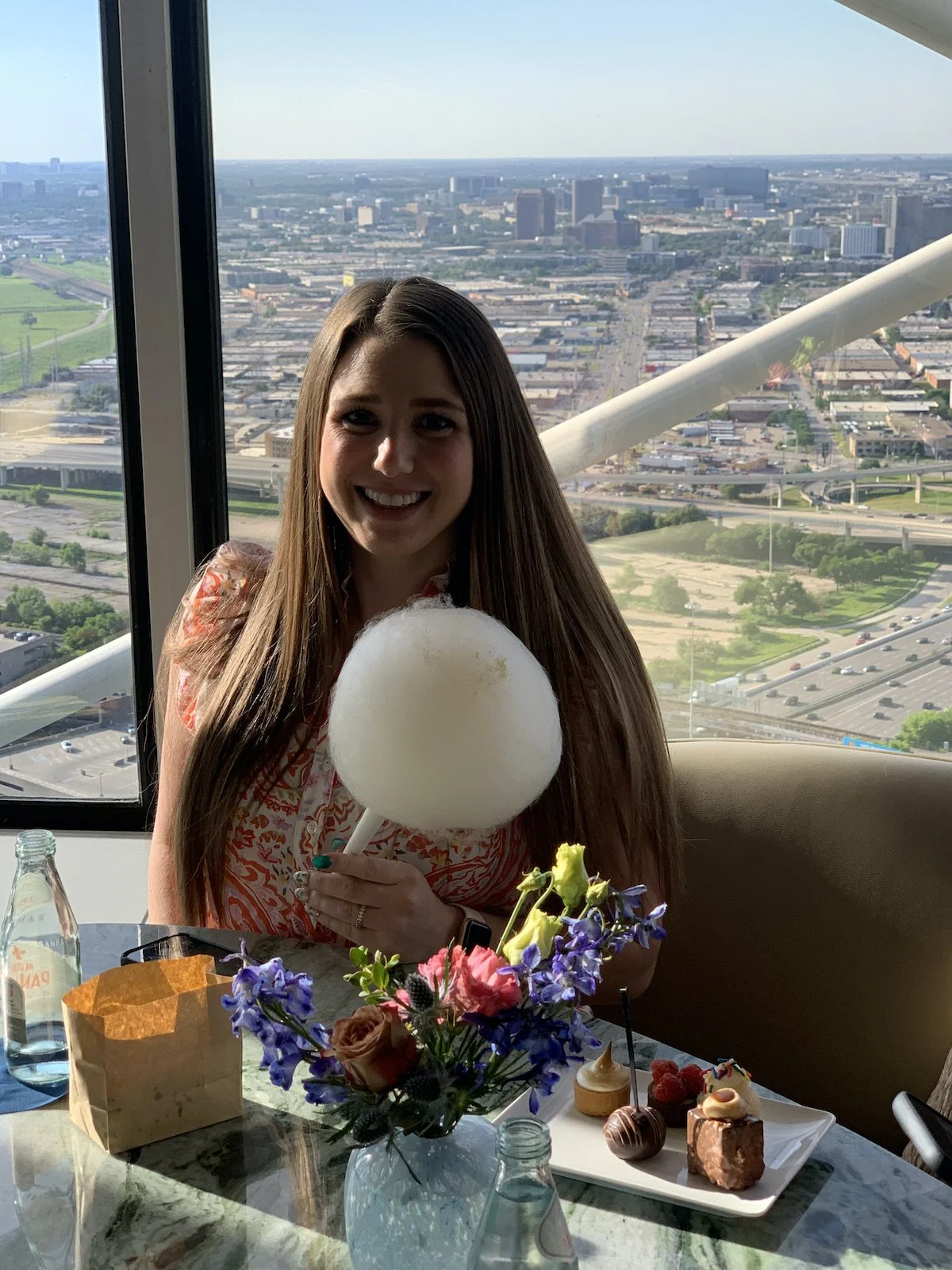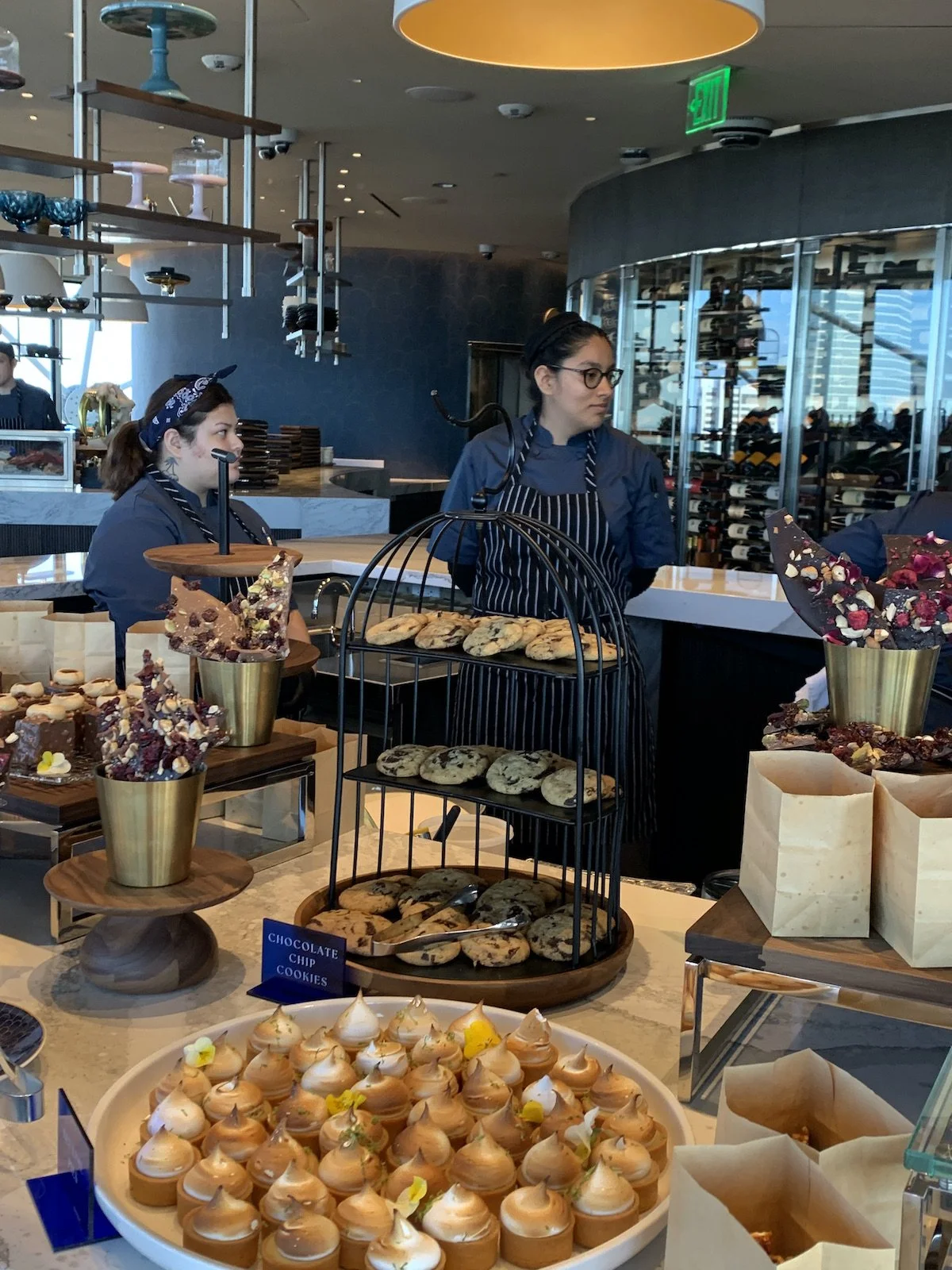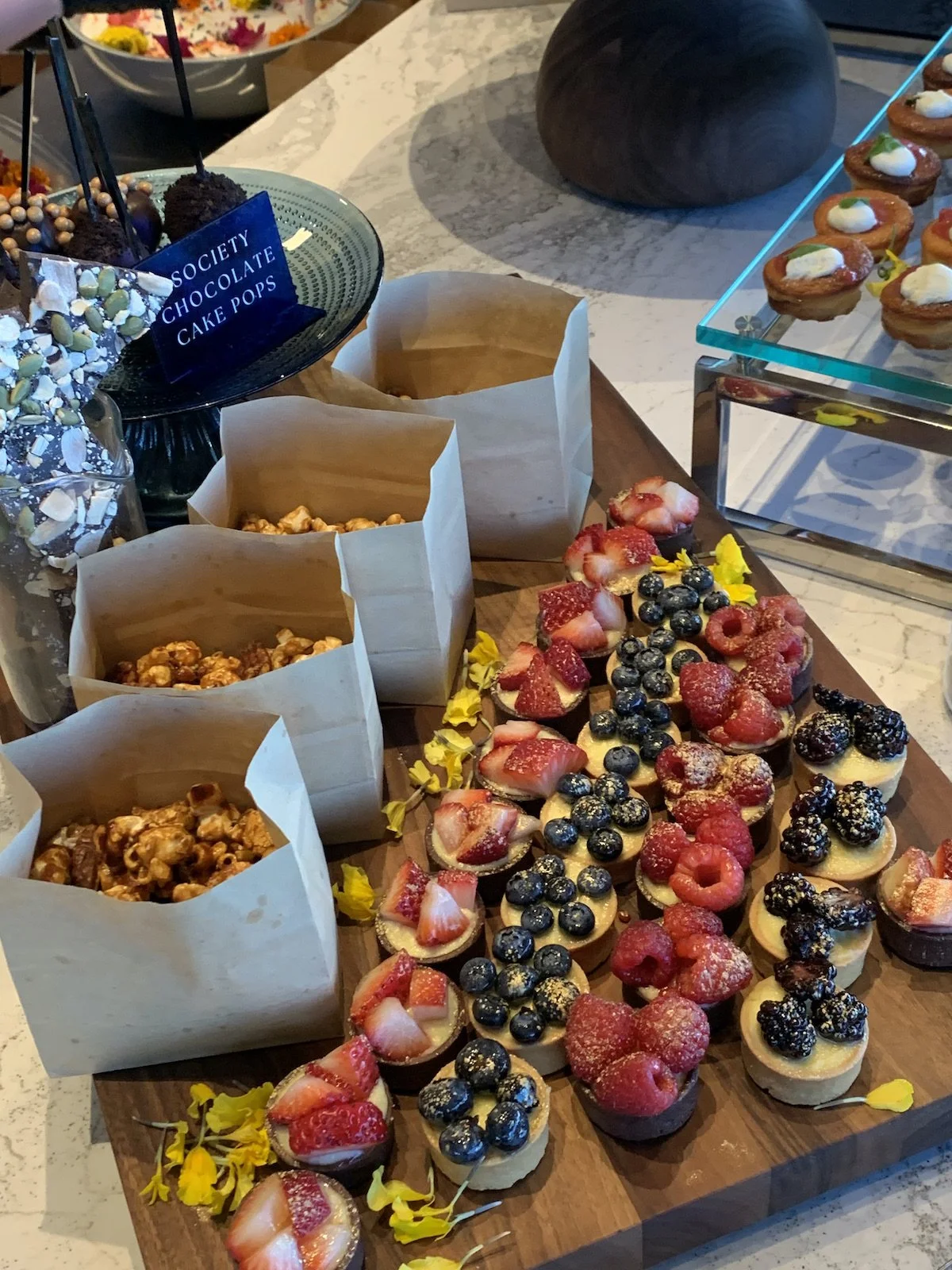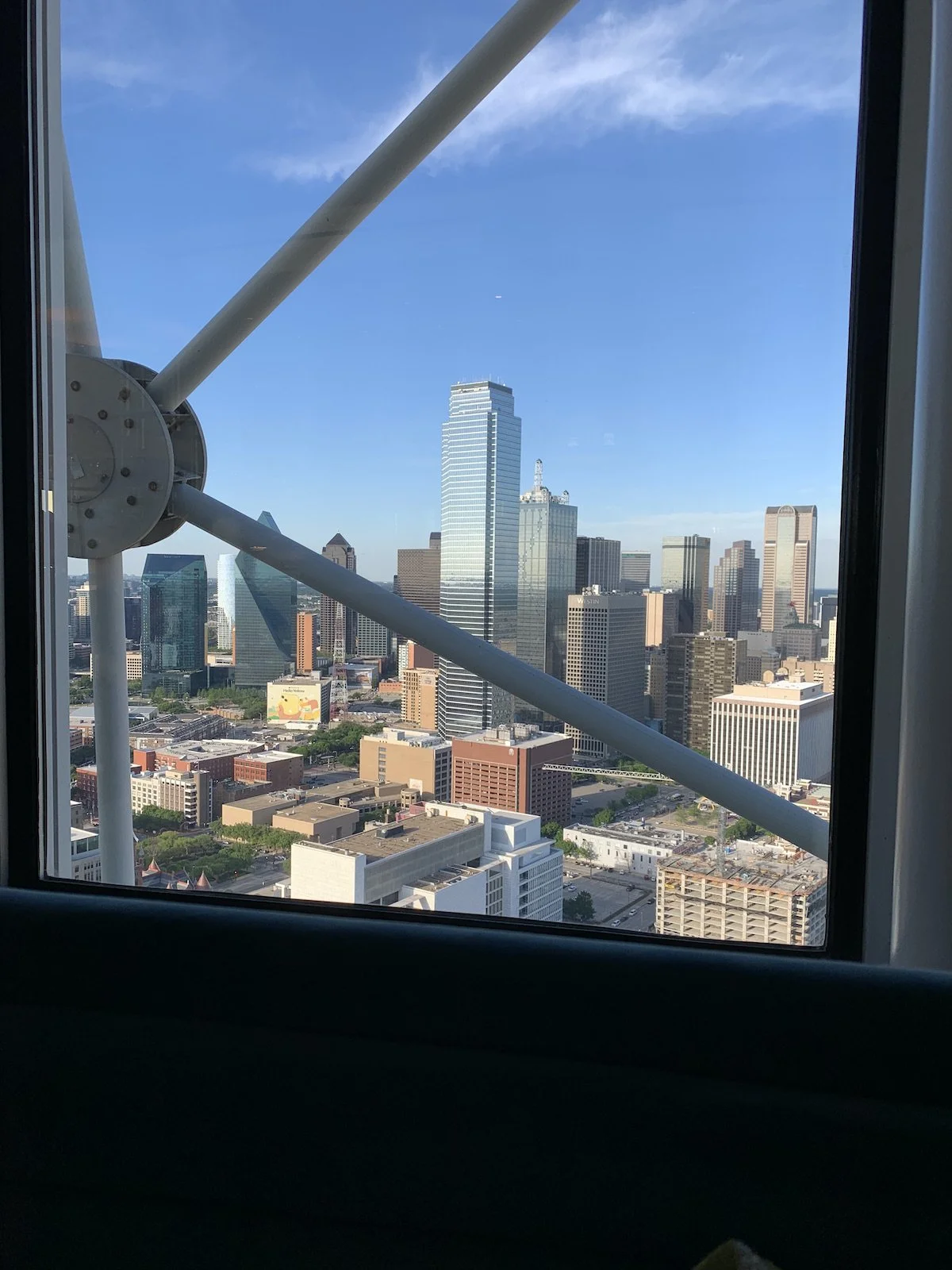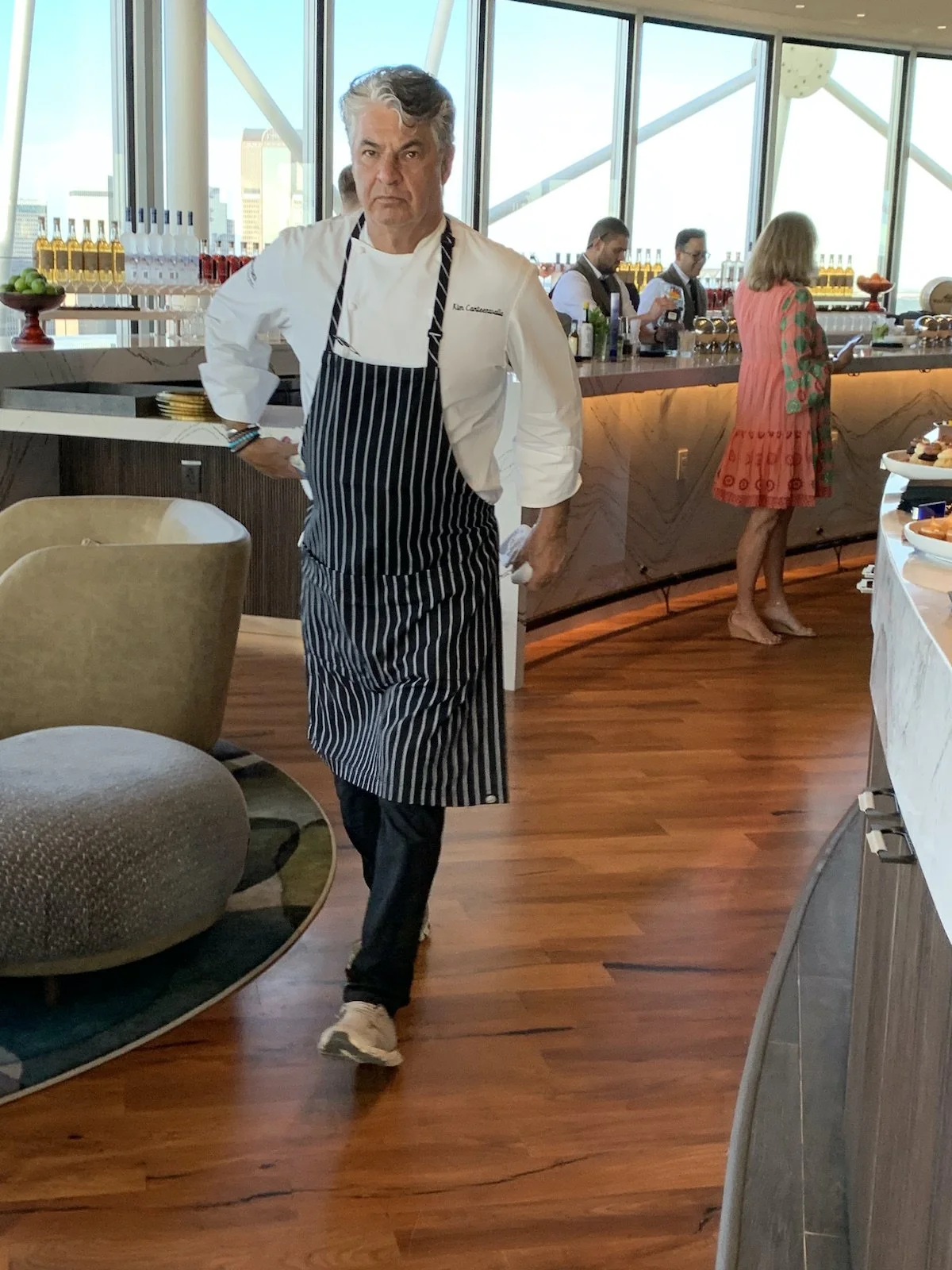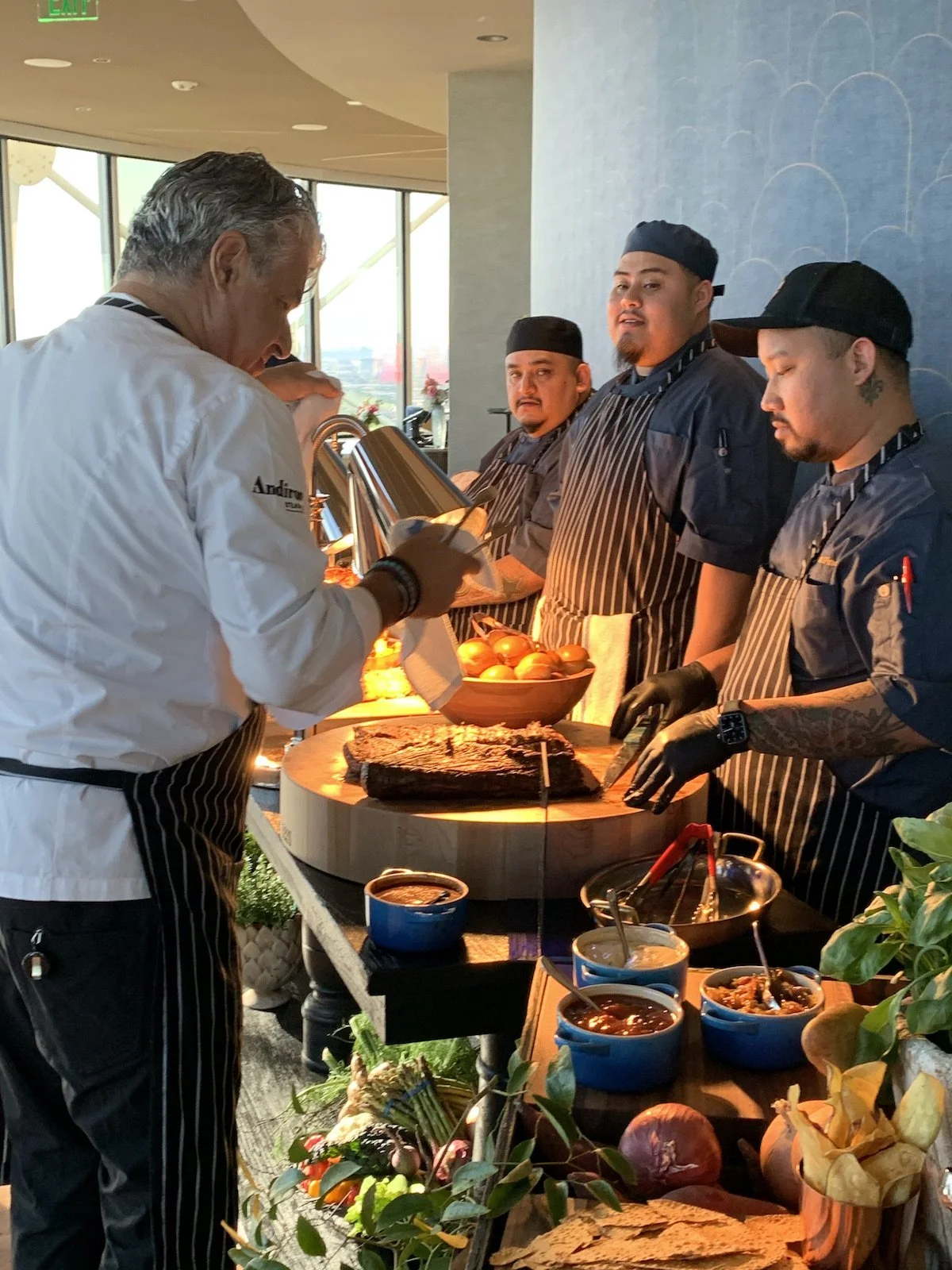Crowning Glory
Creating Artwork for Crown Block Restaurant in Dallas
The elevator ride is swift, a bit of Willy Wonka magic, and the attendant encourages us to watch the view unfold beyond the glass wall. The broad Texas sun sets in the west, shooting streaks of orange and gold across the mirrored Dallas skyline. The doors open and a cool, crisp air beckons us to step inside, past the wine bottle sanctuary into the spacious, floor-to-ceiling glass sphere that holds Crown Block, the new restaurant gracing the top of the iconic Reunion Tower in downtown Dallas. The new restaurant imagined by celebrity chef Kim Canteenwalla and his wife/business partner and restaurant design guru Elizabeth Blau of Blau & Associates soars above the fray of downtown Dallas with what feels like all of Texas spread out at its boot heel.
I am one of the lucky ones who get to experience Crown Block and Chef Kim’s culinary magic first because, in a way, I am part of the team who helped tell the Crown Block story. Unlike Chef Kim, I am not much good in the kitchen; rather I work my creative magic in an art studio. I was fortunate to be selected as one of three artists commissioned to create work for the new space. As is often the case for me, I was recommended to the client by an art consulting firm, in this case Art+Artisans (Austin), who collaborated with the interior design team CoberKoeda Design Studio (Dallas) to bring the concept to life.
Although I have been a part of many corporate art installations, it is rare that I, as the artist, have any direct involvement with the client or even step foot into the actual space. That separation can be challenging, as the artistic direction can get muddled through the layers of communication, a bit like a youthful game of Telephone only with art terms. And, perhaps surprising to some, I typically never see the finished work in its final home. Indeed, I sing high praises for the art consultants who generously offer high-quality images of the installed artwork without me endlessly begging and harassing them.
So, in this case, not only to be consulted for my ideas for the materials and layout during the design phase, but to be invited to attend such a fancy coming-out party for the restaurant, I felt pretty darn good about the whole thing. Worth the extremely short turnaround time that precipitated the opening.
As fate would have it, I traveled solo to attend the media event, but not knowing anyone actually freed me to absorb the surroundings. After walking the full circumference of the space and taking the obligatory photos of the gorgeous pink cocktails, fluffy maple cotton candy confections, decadent chocolate pastries, succulent beef boards and sushi bars, I snapped some quick photos of my artwork being lit by the setting sun, admired the other artwork by San Antonio artist Alejandro Luna and Santa Fe artist William T. Carson, before settling into some Texas-sized people watching.
I instantly recognized Chef Kim’s distinguished gray hair and chiseled features. He seemed to be everywhere at once, adjusting dishes, giving directions, smiling at visitors, in constant motion. He exuded a focused energy that I understand; it’s the way I feel when a commission artwork is in its final stages and I am tweaking the details before applying the finish coat. All of the ideas, the planning, the experimentation, come down to this moment. Maybe it all falls into place. Or possibly it doesn’t. Maybe the client will love it. Maybe they won’t.
No matter how many artworks I create, there is still a fragile moment when you realize you have to let the client (or the world) see it and thereby have the opportunity to judge it. I now see the same is true for chefs. It is exhilarating and nauseating in the same breath.
I watch Chef Kim and his designer/wife Elizabeth glide by one another, smiling, and I appreciate their teamwork and obvious mutual respect. Their joint vision creates a dining experience that feels authentic and truthful. Elizabeth’s attention to detail and desire to understand the city that houses this beautiful restaurant shows. She has created a space that pays homage to the oil industry that permeates this city’s history with grace, elegance and sophistication while working with Chef Kim to feature ingredients from regional farms, ranches, and the Gulf of Mexico.
Take the name: Crown Block. Like most of the visitors, I, too was initially unfamiliar with the term, but digging down a little deeper I learned that the crown block is an essential component of an oil rig's drilling equipment. The crown block is a large, stationary steel structure that is positioned at the top of the derrick, with the primary purpose of providing a stable platform to support the rig's drilling line. As the drilling line is pulled and released, the crown block raises and lowers the bit and other tools necessary for drilling operations. By providing a stable platform, the crown block ensures that the drill bit and other tools can be raised and lowered in a controlled manner, ensuring the safety of the crew and the integrity of the wellbore.
So why name a restaurant after a piece of oil drilling equipment? Anyone who remembers J.R. Ewing knows Dallas is synonymous with Cadillac-driving, big-spending oil magnates. The history of the black gold rush in Dallas goes back to the early 1900s, when a major oil discovery in nearby Corsicana triggered a frenzy of drilling and exploratio in the state, and Dallas became a major hub for the oil industry throughout the 20th century, with big names like Exxon, Gulf Oil, and Sun Oil establishing headquarters.
Fast-forward to 1978 when billionaire Ray L. Hunt decided to construct the the 560-foot Reunion Tower, affectionately known as “The Ball” as part of an urban redevelopment project that also renovated the historic Union Station. Only two previous restaurants have hovered over the city in The Ball ( the original Antares and the previous tenant Five Sixty by Wolfgang Puck). The Hunt family continues to own the building and Hunt’s grandson, Tyler Kleinert, led the search to find the right team to create the new restaurant for the iconic space, seeking to continue his grandfather’s vision for Reunion Tower to be a place to create community. Countless marriage proposals, anniversaries, birthdays, graduations and other milestones have been celebrated at The Ball, and undoubtedly countless more will be at Crown Block.
As the sun faded, I caught a glimpse of the reflection of The Ball on a neighboring skyscraper and noticed the tower actually resembles an oil well; was that an intentional design choice? Before I leave I finally have the opportunity to thank my gracious hosts, Chef Kim and Elizabeth, which enables me to introduce myself to them and express my gratitude for the opportunity to work on this project. Both are effusive with their praise for my artwork and I confess I am both happy and relieved to know they are pleased with the final piece. Elizabeth confides that she was underwhelmed with the original art options suggested for the space. For her, they felt generic, more suited for a chain of hotels than a special occasion restaurant floating over one of the most iconic cities in America. I was touched that she connected with my artwork and appreciated the sense of story that I could help bring to the space. She said she was thrilled when I presented the idea of creating the artwork using pages of the vintage publication Petroleum Engineer published in Dallas in the 1940s.
I remember how excited I was to stumble across some back issues of Petroleum Engineer, a publication that provided articles relevant to folks getting their hands dirty in the oil industry as well as manuals with hundreds of tables charting oil to water ratios, among other calculations. The reverse side of the pages were utilized as advertising space, showcasing the leading drilling equipment, oilfield services and materials. I think manuals and handbooks are fascinating, offering revealing glimpses into daily life. Outlining routines and processes, manuals reflect the daily regimen of regular men and women who, collectively, create the backbone of the community that fuels the industry. Whether in the oilfield or the kitchen, those working communities enable the big payoffs— be it “grand openings” or “gushers” — that ultimately support the broader community.
I descend from the restaurant, thankful for the opportunity to be a small part of this new, but continuing story. I am grateful for interior designers and art consultants who promote art as a way to elevate a space. I am especially grateful for clients who have the vision to insist on authentic details—including original art—that enrich the experience they create. As Crown Block demonstrates, when thoughtfully combined, food, art, and ambiance create a powerful elixir.

